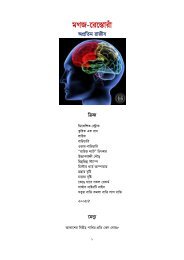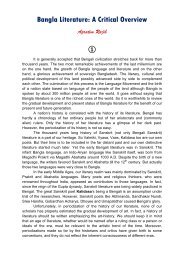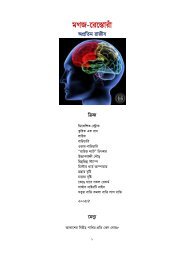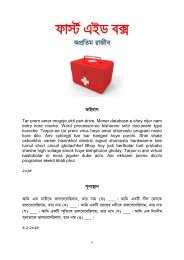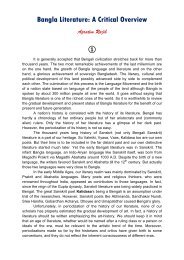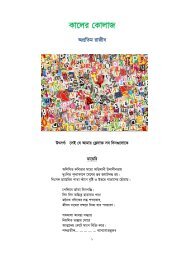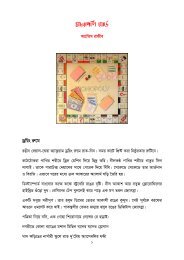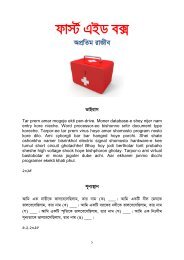BLiterature-Apratim
You also want an ePaper? Increase the reach of your titles
YUMPU automatically turns print PDFs into web optimized ePapers that Google loves.
14<br />
The Romantic Age or The Age of Tagore<br />
(1890-1936)<br />
Romanticism can be defined as an idealized and lofty vision of the temporal<br />
world which, to the general mind, may seem bizarre or unfamiliar. The origin of this<br />
concept may be dated back to the antique philosopher Plato’s time.<br />
In Bangla literature, Romanticism was introduced by Bankim and it reached<br />
an incredible height in Rabindranath Tagore’s (1861-1941) era. It came possible<br />
not only through his outstanding individual achievement but also through ambitious<br />
efforts of many other writers of the age who were influenced by his style and diction.<br />
Tagore’s age started with the publication of his Manashi (1890), a lyrical<br />
poetical work. It came to an end in 1936 with the coming to light of Jibanananda’s<br />
book of poems entitled Dhushar Pandulipi.<br />
The difference between Bankim and Tagore is not only artistic but also<br />
ideological. While Bankim was an admirer of Geeta, Tagore was a Brahmo and his<br />
philosophies were based on the Upanishadas. He had a universal vision and loved<br />
this world much more than any other poet has ever done till today. This is why he is<br />
called “Biswa Kavi” (i.e. Poet of the World).<br />
Tagore’s Manashi (1890), Sonar Tori (1894), Chitra (1896), Gitanjali (1912),<br />
Balaka (1916), Punascha (1932), Prantik (1938) are significant contributions to<br />
romantic and mystic poetry. He was awarded the Nobel Literature Prize in 1913 for<br />
Gitanjali, a collection of his mystic poems which he himself translated into English<br />
entitling Song Offerings. Chokher Bali (1903), Gora (1910), Chaturanga (1915),<br />
Shesher Kabita (1929) are his famous novels. He introduced short story in Bangla<br />
and took it to its supreme shape. His short stories are collected in an anthology titled<br />
Galpaguccha. Further, he is also our greatest dramatist; his Chitrangada (1892),<br />
Dakghar (1912) and Raktakarabi (1926) are remarkable plays of world drama.<br />
Three leading literary journals of the era were Bharati, Sabujpatra and Kallol.<br />
Bharati was the early haven of Tagore and some other young writers who wanted to<br />
free themselves of the strong reign of Bankim. Sabujpatra introduced the movement<br />
of a new standard of Bangla prose (called ‘Chalita Bhasha’) led by Pramath<br />
Chowdhury (1868-1946). Tagore himself was engaged with that movement. And<br />
Kallol was the leading journal of the rebels against the dominant literary trend.<br />
Dwijendralal Roy (1863-1913), famed for his historical plays and songs, was<br />
an early literary rival of Tagore. The works of the Tagorean school seemed<br />
extremely modern to the conservatives and they developed as a different group with<br />
Roy – their leader.<br />
The other poets of Tagore’s era gave birth to more or less individualistic styles<br />
but failed to exceed his artistic halo. Among them, Kazi Nazrul Islam (1899-1976)<br />
stands next to him in many respects. He achieved the glory of ‘Rebel poet’; no other<br />
poet has yet succeeded to express so artistically the tone of political rebellion. He<br />
assimilated Hindu, Greco-Roman, Christian and Islamic cultural heritages and thus<br />
exposed himself as a model of non-communal Bengali writers. But unfortunately his<br />
non-communal humanism was turned into sick Pakistanism (influenced by Jinnah’s<br />
two-nation theory) by some later Muslim poets [e.g. Farrukh Ahmad (1918-’74)].




